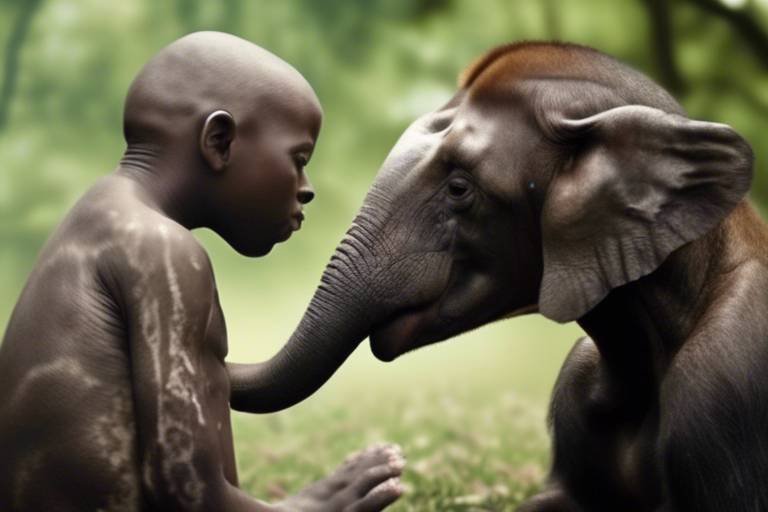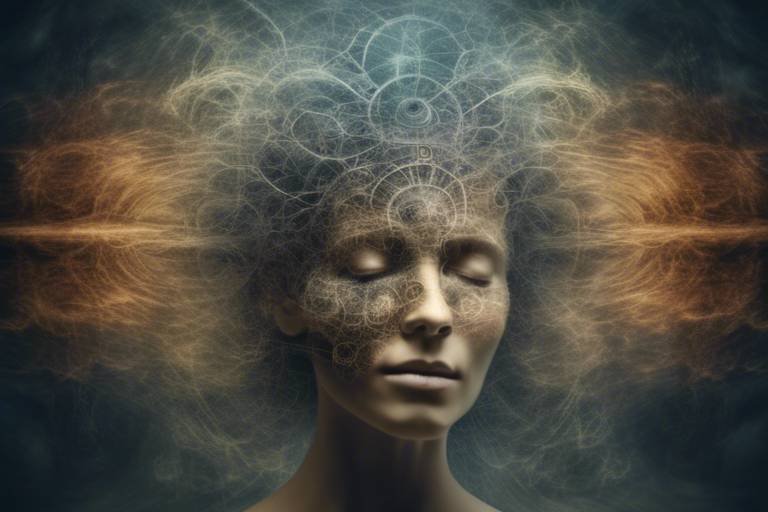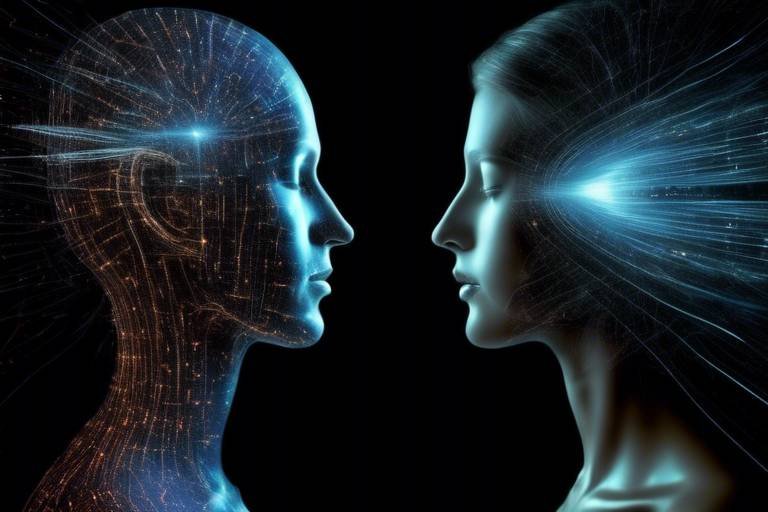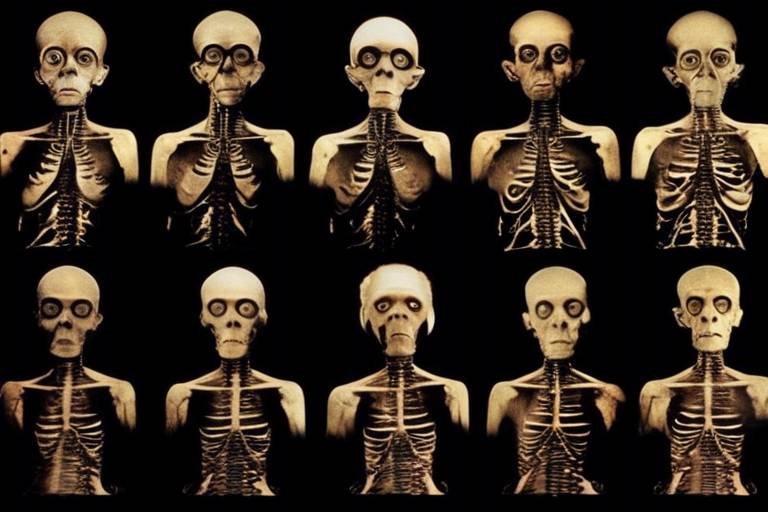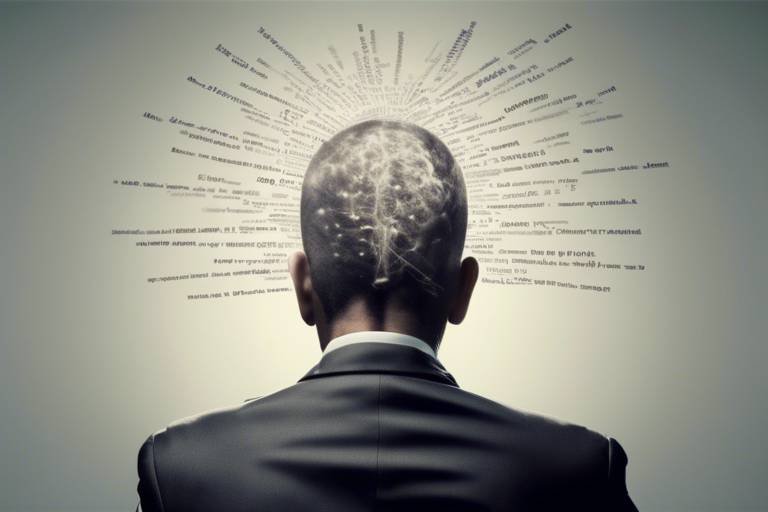Are All Living Beings Conscious?
The question of whether all living beings are conscious is as intriguing as it is complex. At first glance, it seems straightforward: we see ourselves, humans, as the pinnacle of consciousness. But what about the myriad forms of life that inhabit our planet? From the tiniest microorganisms to the majestic blue whale, the spectrum of life is vast and varied. Are they merely responding to stimuli, or do they possess a level of awareness that we have yet to understand? This article dives deep into the concept of consciousness, exploring various perspectives, scientific findings, and philosophical implications surrounding the nature of awareness in different forms of life.
To peel back the layers of this enigma, we must first grapple with the definition of consciousness itself. It's not just about being awake or alert; consciousness encompasses self-awareness, the ability to experience emotions, and the capacity to make choices. In humans, this is evident in our ability to reflect on our thoughts and feelings, a trait that sets us apart from many other species. But as we venture into the animal kingdom and beyond, we start to see behaviors that hint at forms of consciousness we might not have initially considered. For instance, elephants display grief, and crows solve complex problems. These examples challenge us to rethink our definitions and assumptions about awareness.
Moreover, the exploration of consciousness isn't limited to animals; it extends to plants as well. Recent studies have shown that plants can communicate and react to their environment in ways that suggest a form of awareness, albeit very different from what we experience. This challenges traditional views and prompts us to ask: if plants can respond to stimuli and engage in complex behaviors, do they possess a rudimentary form of consciousness? This question opens a Pandora's box of philosophical debates about the nature of life and awareness.
As we journey through this exploration, we will touch upon various aspects of consciousness, including its manifestation in humans and animals, the role of neuroscience, and the emerging ideas surrounding plant consciousness. We'll also delve into altered states of consciousness, providing a broader understanding of how awareness can shift and change. By the end of this article, you may find yourself questioning not just the consciousness of other beings, but the very nature of your own awareness.
- What is consciousness? - Consciousness is the state of being aware of and able to think about one's own existence, thoughts, and surroundings.
- Do all animals have consciousness? - While not all animals exhibit the same level of consciousness, many species show signs of awareness through their behaviors and interactions.
- Can plants be considered conscious? - Emerging research suggests that plants may have a form of awareness, as they can respond to their environment and communicate with one another.
- How does neuroscience relate to consciousness? - Neuroscience studies the brain's structures and functions, providing insights into how conscious experiences arise from neural activity.

The Definition of Consciousness
Understanding consciousness is essential to this discussion, as it forms the bedrock of our exploration into the awareness of living beings. But what exactly is consciousness? It's a term that's often thrown around, yet it eludes a straightforward definition. In essence, consciousness refers to the state of being aware of and able to think about one's own existence, thoughts, and surroundings. This awareness can manifest in various forms, from the simple perception of stimuli to complex self-reflection and introspection.
Different disciplines offer unique interpretations of consciousness. For instance, in psychology, consciousness is often viewed as a continuum, ranging from full alertness to deep sleep. Neuroscience, on the other hand, delves into the biological underpinnings of consciousness, examining how brain activity correlates with conscious experience. Philosophically, consciousness raises profound questions about the nature of reality and existence. It challenges us to consider whether consciousness is a byproduct of physical processes or if it exists independently of the brain.
To further illustrate the complexities of consciousness, let's break it down into several dimensions:
- Awareness: This is the basic level of consciousness, where an organism can respond to stimuli in its environment.
- Self-awareness: This higher level of consciousness involves recognizing oneself as an individual, separate from others and the environment.
- Reflective consciousness: This is the ability to think about one's own thoughts, emotions, and experiences, allowing for deeper understanding and insight.
In addition to these dimensions, consciousness can also be categorized based on its quality and content. The quality refers to the richness of the conscious experience, such as the intensity of emotions felt or the clarity of thoughts. The content, on the other hand, relates to what one is conscious of at any given moment—be it feelings, thoughts, or sensory perceptions.
As we explore consciousness further, it becomes clear that it's not a one-size-fits-all concept. Different species might experience consciousness in ways that are unique to their biological and environmental contexts. This leads us to ponder whether consciousness is a spectrum, where some beings possess a more complex form of awareness than others. Ultimately, the question remains: is consciousness an exclusive trait of humans, or do other living beings share this profound experience in their own ways?

Consciousness in Humans
When we think about consciousness, it’s hard not to feel a sense of awe at the complexity of the human mind. Unlike other species, humans experience a rich tapestry of thoughts, emotions, and self-awareness that shapes our interactions and understanding of the world around us. But what exactly sets our consciousness apart? It’s not just about being awake or aware; it encompasses a profound depth of understanding, empathy, and introspection that many researchers believe is unique to our species.
One of the most fascinating aspects of human consciousness is self-awareness. This ability to recognize oneself as an individual, separate from others, allows us to reflect on our thoughts and actions. We ask ourselves questions like, "Who am I?" or "What do I want?" This self-reflective capability is a cornerstone of human identity, influencing our decisions and relationships. It’s like looking into a mirror that not only shows our physical appearance but also our emotional and intellectual selves.
Moreover, the emotional depth of human consciousness is another critical factor. We experience a wide range of emotions, from joy and love to sadness and anger. These emotions are not just fleeting feelings; they shape our memories and influence our behavior. For instance, consider how a cherished memory can bring a smile to your face years later. This emotional connection to our past enhances our consciousness, enabling us to learn and grow from our experiences.
In addition to self-awareness and emotional depth, humans possess advanced cognitive abilities. Our capacity for abstract thinking, problem-solving, and creative expression is unparalleled in the animal kingdom. This cognitive prowess allows us to create art, develop complex languages, and engage in scientific inquiry. We can ponder existential questions and explore the mysteries of the universe, which adds another layer to our consciousness.
To better understand the intricacies of human consciousness, let’s take a look at some of the key characteristics that define our conscious experience:
- Self-Reflection: The ability to think about one’s own thoughts.
- Emotional Complexity: The diverse range of emotions we can experience.
- Abstract Thinking: Our capacity to think beyond the immediate and tangible.
- Social Awareness: Understanding social dynamics and the feelings of others.
But how does all this happen in our brains? That’s where neuroscience comes into play. Neuroscience has made significant strides in uncovering how different brain structures contribute to our conscious experience. For instance, the prefrontal cortex is heavily involved in decision-making and self-control, while the limbic system plays a crucial role in emotion regulation. Scientists use advanced imaging techniques to observe brain activity, helping us map the neural correlates of consciousness.
In summary, human consciousness is a multifaceted phenomenon that encompasses self-awareness, emotional depth, and advanced cognitive abilities. It’s a unique blend of factors that allows us to navigate our lives with a sense of purpose and understanding. As we continue to explore the depths of our consciousness, we uncover not only the essence of what it means to be human but also the connections we share with other living beings.
- What is consciousness? Consciousness is the state of being aware of and able to think about one’s own existence, thoughts, and surroundings.
- How does consciousness differ between humans and animals? While many animals exhibit signs of awareness, human consciousness is characterized by higher levels of self-awareness, emotional complexity, and cognitive abilities.
- Can consciousness be measured? Researchers use various methods, including brain imaging and behavioral studies, to investigate and quantify aspects of consciousness.

Neuroscience and Consciousness
Neuroscience, the scientific study of the nervous system, plays a pivotal role in unraveling the intricate tapestry of consciousness. It seeks to understand not just the mechanics of the brain, but also how these mechanics give rise to our experiences, thoughts, and emotions. Imagine your brain as a complex orchestra, where each section—strings, brass, woodwinds—represents different neural networks working in harmony to create the symphony of consciousness. But how do these neural activities translate into what we perceive as awareness?
At the heart of this exploration lies the relationship between brain structures and conscious experience. Various regions of the brain have been identified as critical for different aspects of consciousness. For instance, the prefrontal cortex is often associated with higher-order functions such as decision-making and self-reflection, while the thalamus acts as a relay station, channeling sensory information to the appropriate areas of the brain. This division of labor highlights the complexity of our conscious experience, akin to a well-coordinated team where each member has a specific role to play.
Key studies in neuroscience have employed advanced imaging techniques, such as functional magnetic resonance imaging (fMRI) and electroencephalography (EEG), to observe brain activity in real-time. These studies have revealed fascinating insights into how certain patterns of neural activity correlate with conscious experiences. For example, researchers have found that when individuals engage in tasks requiring attention or focus, specific brain regions light up like a city skyline at night, illuminating our understanding of how consciousness manifests in the brain.
Moreover, the concept of altered states of consciousness has garnered significant interest in neuroscience. Whether through meditation, sleep, or the influence of psychoactive substances, these states challenge our traditional understanding of awareness. During meditation, for instance, studies show changes in brainwave patterns that suggest a shift in consciousness, leading to heightened awareness or even a sense of oneness with the universe. This phenomenon raises intriguing questions: What happens to our consciousness when we alter our brain's usual state? Are we tapping into a deeper layer of awareness?
To further illustrate the relationship between brain activity and consciousness, consider the following table summarizing key brain regions and their associated functions:
| Brain Region | Function |
|---|---|
| Prefrontal Cortex | Decision-making, self-awareness |
| Thalamus | Sensory relay, attention |
| Hippocampus | Memory formation, spatial navigation |
| Amygdala | Emotion regulation, fear response |
As we delve deeper into the interplay between neuroscience and consciousness, it's essential to acknowledge the ongoing debates and research in this field. While significant strides have been made, the question of how subjective experiences arise from physical processes remains one of the most profound mysteries in science. It's like trying to explain the beauty of a sunset through the lens of physics alone—while we can describe the light and the atmosphere, the essence of the experience often eludes concrete explanation.
In conclusion, neuroscience provides invaluable insights into the mechanisms behind consciousness, revealing the complexity and richness of our conscious experiences. As we continue to explore this fascinating intersection of science and philosophy, we may uncover even more about what it means to be aware and alive in this intricate web of existence.
- What is consciousness? Consciousness refers to the state of being aware of and able to think about one's own existence, thoughts, and surroundings.
- How does neuroscience study consciousness? Neuroscience studies consciousness by examining brain activity and structure through techniques like fMRI and EEG.
- Can animals be conscious? Yes, many studies suggest that various animal species exhibit signs of consciousness through their behaviors and cognitive abilities.
- What are altered states of consciousness? These are states that differ from normal waking consciousness, often induced by meditation, sleep, or drugs, which can change our perception and awareness.

Brain Activity and Awareness
When we dive into the intricate relationship between brain activity and awareness, we uncover a fascinating landscape that reveals how our minds work. Imagine your brain as a bustling city, where different areas light up like neon signs, each representing specific thoughts, emotions, or actions. This analogy helps us understand that our conscious experience is not a singular event; it’s a symphony of neural interactions that create the soundtrack of our awareness.
Research has shown that specific patterns of neural activity are closely linked to our conscious experiences. For instance, when you make a decision, certain areas of your brain activate, reflecting your thought process. A study conducted by neuroscientists at Johns Hopkins University utilized functional magnetic resonance imaging (fMRI) to observe brain activity during decision-making tasks. They found that the prefrontal cortex, known for its role in complex cognitive behavior, lights up significantly when individuals are aware of their choices. This suggests that our conscious awareness is deeply rooted in the brain's architecture.
Furthermore, the timing of these neural activations is crucial. It’s not just about which areas are active, but when they activate. The temporal dynamics of brain activity can influence our perception of time and our awareness of events. For example, if you’re watching a thrilling movie, your brain processes visual and auditory information in real-time, creating a seamless experience of awareness. If there’s a delay in processing, it can lead to a disjointed perception, making you feel as if you're lagging behind the action.
Interestingly, altered states of consciousness, such as those experienced during meditation or under the influence of certain substances, provide further insight into this relationship. During deep meditation, studies have shown a significant increase in alpha waves, which are associated with relaxation and heightened awareness. This indicates that even when we’re not actively engaged in decision-making or problem-solving, our brain is still busy, albeit in a different mode. The brain’s ability to shift gears in response to our state of consciousness is a testament to its remarkable flexibility.
To illustrate the connection between brain activity and awareness, consider the following table that summarizes key brain areas involved in different states of consciousness:
| State of Consciousness | Key Brain Areas | Associated Activity |
|---|---|---|
| Normal Wakefulness | Prefrontal Cortex, Parietal Lobe | High cognitive function, decision-making |
| Sleep | Thalamus, Hippocampus | Memory consolidation, dreaming |
| Meditation | Frontal Cortex, Insula | Increased alpha waves, relaxation |
| Drug-Induced States | Various, including Limbic System | Altered perception, euphoria |
In conclusion, the interplay between brain activity and awareness is a complex and ever-evolving field of study. As we continue to explore how our brains function, we gain deeper insights into the very nature of consciousness itself. It’s like peeling back the layers of an onion; each layer reveals more about our existence and the essence of being aware. This understanding not only enhances our knowledge of ourselves but also opens up new avenues for exploring consciousness in other living beings.
- What is the relationship between brain activity and consciousness? Brain activity is closely linked to consciousness, with specific patterns of neural activation correlating with different states of awareness.
- Can altered states of consciousness affect brain function? Yes, altered states, such as those induced by meditation or drugs, can significantly change brain function and the patterns of neural activity.
- How do scientists measure brain activity related to consciousness? Scientists use techniques like fMRI and EEG to monitor brain activity and identify which areas are involved in conscious thought and awareness.

Altered States of Consciousness
When we think about consciousness, we often imagine a steady stream of awareness that defines our daily lives. However, the reality is that consciousness can be as fluid as a river, shifting and changing shape. (ASCs) provide a captivating glimpse into this fluidity, revealing how our awareness can expand, contract, or even transform entirely. These states can arise from various sources, including meditation, dreaming, and the use of certain substances. Each of these experiences offers unique insights into the nature of consciousness itself.
Take meditation, for instance. Practitioners often report a profound sense of peace and heightened awareness that transcends ordinary experience. This state isn’t just about relaxation; it’s a deep dive into the self, where individuals may encounter thoughts and feelings they didn’t even know existed. Studies have shown that meditation can alter brain activity, leading to increased connectivity in areas associated with emotional regulation and self-awareness. It’s as if the mind is tuning into a different frequency, allowing for a richer tapestry of experience.
Then there’s dreaming, which serves as another fascinating example of altered consciousness. During sleep, particularly in the REM (Rapid Eye Movement) phase, our brains become incredibly active. Dreams can feel vivid and real, often blurring the lines between fantasy and reality. Some researchers suggest that dreams may serve important functions, such as processing emotions or solving problems. In this way, dreaming can be seen as a unique state of consciousness where our mind explores possibilities and scenarios that our waking life may not allow.
But what about substances? The use of psychedelics, for instance, has been a topic of interest for both scientists and spiritual seekers alike. These substances can induce profound changes in perception, thought, and emotion. Users often describe experiences of interconnectedness, heightened sensory perception, and even mystical encounters. Research in this area is expanding, with studies suggesting that psychedelics may promote neuroplasticity and emotional healing. However, they also raise questions about the nature of reality and how our brains construct our conscious experience.
In exploring these altered states, it’s essential to recognize the implications they hold for our understanding of consciousness. Are these experiences mere tricks of the mind, or do they reveal deeper truths about our existence? The answer is likely complex and multifaceted. As we delve further into the science of consciousness, we may find that ASCs are not just anomalies but integral parts of the human experience, shaping how we perceive ourselves and the world around us.
Ultimately, altered states of consciousness challenge our conventional views, inviting us to reconsider what it means to be aware. Whether through meditation, dreaming, or psychedelics, these experiences can illuminate aspects of consciousness that remain hidden in our everyday lives. As we continue to explore these states, we may uncover new dimensions of awareness that enrich our understanding of what it means to be alive.
- What are altered states of consciousness?
Altered states of consciousness (ASCs) are mental states that differ significantly from normal waking consciousness. They can be induced by various factors, including meditation, sleep, and psychoactive substances. - How does meditation affect consciousness?
Meditation can lead to deep relaxation and heightened awareness, allowing individuals to access different levels of consciousness and emotional insights. - Are dreams a form of altered consciousness?
Yes, during REM sleep, our brains are highly active, and dreams can provide profound insights into our emotions and thoughts, representing a unique state of consciousness. - What role do psychedelics play in understanding consciousness?
Psychedelics can induce significant changes in perception and cognition, prompting questions about reality and consciousness, and are being researched for their therapeutic potential.

Theories of Consciousness
The quest to understand consciousness is as old as humanity itself, and over the years, various theories have emerged, each attempting to unravel the mysteries of awareness. These theories can be broadly categorized into several schools of thought, each offering a unique lens through which we can view consciousness. At the heart of this exploration lies the fundamental question: What does it mean to be conscious? Is consciousness merely a byproduct of complex brain processes, or does it represent something more profound?
One of the most prominent theories is dualism, famously championed by philosopher René Descartes. Dualism posits that the mind and body are two distinct entities. According to this view, consciousness is not just a product of physical processes in the brain but rather a separate, non-physical phenomenon. This idea raises intriguing implications about the nature of existence and the afterlife, suggesting that our consciousness could continue beyond our physical form.
In contrast, we have physicalism, which argues that everything about consciousness can be explained through physical processes. Proponents of this theory believe that consciousness arises from complex interactions of neurons and brain structures. This perspective is heavily supported by advancements in neuroscience, which have shown that specific brain activities correlate with conscious experiences. For instance, studies using functional MRI scans have demonstrated how certain areas of the brain activate during particular thoughts or sensations, indicating a direct link between brain activity and consciousness.
Another fascinating theory is panpsychism, which suggests that consciousness is a fundamental feature of the universe, present in varying degrees in all entities, from humans to animals to even inanimate objects. This theory challenges our conventional understanding by proposing that everything possesses a form of awareness, albeit at different levels. Imagine a rock being aware of its existence in a very rudimentary manner, or trees having a form of consciousness that allows them to respond to their environment. While this may sound far-fetched, it opens up a dialogue about the interconnectedness of all living things.
To further illustrate these theories, consider the following table that summarizes the key characteristics of each:
| Theory | Key Characteristics |
|---|---|
| Dualism | Mind and body are separate; consciousness exists beyond physical form. |
| Physicalism | Consciousness arises from brain processes; everything can be explained physically. |
| Panpsychism | Consciousness is a fundamental feature of all entities; exists in varying degrees. |
While each theory presents compelling arguments, the debate continues, and no single theory has emerged as the definitive explanation for consciousness. This ongoing discourse is not just an academic exercise; it profoundly impacts how we understand ourselves and our place in the universe. As we delve deeper into the mysteries of consciousness, we must remain open to the possibility that our understanding may evolve, just as our awareness does.
In conclusion, the theories of consciousness offer a fascinating glimpse into the complexities of awareness. Each theory, whether it leans towards the physical or the metaphysical, contributes to our broader understanding of what it means to be alive and aware. As we explore these concepts, we invite you to ponder: What do you believe consciousness truly is?
- What is consciousness? Consciousness is the state of being aware of and able to think about one's own existence, thoughts, and surroundings.
- Can animals be conscious? Yes, many studies suggest that various animal species exhibit signs of consciousness, including self-awareness and complex behaviors.
- What is the difference between dualism and physicalism? Dualism posits that the mind and body are separate, while physicalism argues that consciousness arises from physical processes in the brain.
- Is panpsychism a widely accepted theory? Panpsychism is gaining attention but remains a controversial and debated perspective in the study of consciousness.

Consciousness in Animals
When we think about consciousness, our minds often drift to the intricate tapestry of human thought and emotion. However, the exploration of consciousness doesn't stop with us. In fact, the animal kingdom presents a fascinating array of evidence suggesting that many species possess their own forms of awareness. From the playful antics of dolphins to the complex social structures of elephants, animals exhibit behaviors that hint at a rich inner life. But what does this really mean? Are these creatures merely reacting to stimuli, or do they have a genuine sense of self and awareness?
Research in animal cognition has exploded in recent years, revealing that consciousness may not be a uniquely human trait. For instance, studies have shown that certain animals can recognize themselves in mirrors, a behavior that indicates self-awareness. This phenomenon has been observed in species such as:
- Great apes (e.g., chimpanzees, orangutans)
- Dolphins
- Asian elephants
Additionally, many animals display complex social behaviors that require a level of understanding and empathy. Take the case of elephants: these majestic creatures not only mourn their dead but also exhibit altruistic behaviors, helping injured or distressed members of their herd. This emotional depth suggests a form of consciousness that goes beyond mere survival instincts.
Moreover, the cognitive abilities of various species have been compared through comparative consciousness studies. These studies aim to investigate how different animals perceive their environment and make decisions. For example, researchers have found that crows and parrots can solve problems in ways that indicate advanced reasoning skills, much like those seen in primates. Such findings challenge the traditional view that only mammals possess high levels of consciousness.
But what about the less obvious candidates for consciousness? Some scientists argue that even creatures like octopuses, with their unique neural structures and behaviors, might possess a form of awareness. These intelligent invertebrates have demonstrated problem-solving skills and can even exhibit playfulness, raising questions about the nature of consciousness across different life forms.
As we continue to explore the depths of animal consciousness, we must also consider the implications of our findings. Understanding that many animals may experience their own forms of awareness can significantly impact how we interact with and treat them. It invites us to rethink our ethical responsibilities towards other sentient beings and recognize the rich emotional lives they may lead.
In conclusion, the exploration of consciousness in animals opens a Pandora's box of questions and challenges our preconceived notions about the mind. As we delve deeper into this intriguing subject, we find ourselves at the intersection of science and philosophy, where the lines between human and animal consciousness begin to blur. The more we learn about the inner lives of animals, the more we realize that consciousness might be a spectrum, rather than a binary state reserved solely for humans.
- What is consciousness in animals? Consciousness in animals refers to the awareness and ability to perceive their environment, make decisions, and experience emotions.
- Which animals are considered to have consciousness? Various animals, including great apes, dolphins, elephants, and certain bird species, have shown behaviors indicative of consciousness.
- How do scientists study animal consciousness? Scientists study animal consciousness through behavioral observations, cognitive tests, and comparative studies across different species.
- Can plants be conscious? While traditional views do not consider plants conscious, emerging research suggests they may exhibit awareness through complex behaviors and communication.

Comparative Consciousness Studies
When we dive into the fascinating world of , we open a treasure chest filled with insights about how different species perceive their surroundings and experience life. Imagine walking through a vibrant forest, where each creature, from the tiniest ant to the majestic elephant, possesses its own unique form of awareness. This section explores the research that compares cognitive functions across various species, revealing astonishing similarities and differences in consciousness.
One of the most compelling aspects of these studies is the way they challenge our traditional views of intelligence and awareness. For instance, did you know that some birds, like crows and parrots, have shown remarkable problem-solving abilities that rival those of primates? These findings suggest that consciousness isn't solely the domain of mammals; it spans a broader spectrum of life. In fact, researchers have discovered that many species exhibit behaviors indicating a level of self-awareness and social interaction that we once believed was exclusive to humans.
To illustrate the diversity of consciousness in the animal kingdom, consider the following table, which summarizes various species and their cognitive abilities:
| Species | Cognitive Ability | Evidence of Consciousness |
|---|---|---|
| Crows | Problem-solving, tool use | Use of tools to obtain food |
| Dolphins | Complex communication, social structures | Recognition of self in mirrors |
| Elephants | Empathy, mourning rituals | Grieving for deceased companions |
| Octopuses | Escape artistry, problem-solving | Ability to navigate complex mazes |
As we analyze these intriguing behaviors, we must also consider the implications of such findings. Are we prepared to redefine what it means to be "conscious"? The evidence suggests that consciousness exists on a continuum, with various species exhibiting different levels of awareness based on their evolutionary adaptations. For example, while dogs may not solve puzzles as adeptly as crows, their emotional intelligence and ability to read human cues demonstrate a profound form of consciousness.
Moreover, comparative consciousness studies often involve behavioral experiments that test an animal's ability to recognize itself, communicate, or solve problems. These experiments are crucial in understanding the cognitive landscape of non-human species. They help us appreciate the rich tapestry of life and consciousness on our planet, prompting us to ask deeper questions about our own place within this web of awareness.
In conclusion, comparative consciousness studies remind us that consciousness is not a binary concept reserved for humans alone. Instead, it is a fascinating spectrum that invites us to explore the minds of various species, broadening our understanding of what it means to be aware. The next time you encounter an animal, whether it's a beloved pet or a wild creature, take a moment to ponder the complexity of its consciousness and the shared experience of life that we all partake in.
- What is comparative consciousness? Comparative consciousness refers to the study of consciousness across different species to understand how various organisms perceive and interact with their environment.
- Do animals experience emotions like humans? Yes, many studies indicate that animals experience a range of emotions, suggesting a form of consciousness and awareness similar to humans.
- How do researchers study consciousness in animals? Researchers use behavioral experiments, neuroanatomical studies, and observational methods to assess cognitive abilities and signs of awareness in various species.
- Can plants be considered conscious? While traditional views do not classify plants as conscious beings, emerging research on plant behavior and communication is challenging this notion.

Plant Consciousness: A Controversial Topic
The concept of plant consciousness has sparked heated debates among scientists, philosophers, and nature enthusiasts alike. While many people associate consciousness with animals, particularly mammals, the idea that plants might possess some form of awareness challenges our traditional views of life and intelligence. So, what does it mean for a plant to be conscious? Can they think, feel, or even communicate in ways that we don’t fully understand? These questions open up a fascinating dialogue about the nature of consciousness itself.
Recent research has begun to reveal that plants are far more complex than we ever imagined. They may not have brains or nervous systems like animals, but they do exhibit behaviors that suggest a level of awareness. For instance, studies have shown that plants can respond to their environment in intricate ways, such as adjusting their growth patterns based on light exposure or even communicating with other plants through chemical signals. This leads us to ponder: if plants can interact with their surroundings and other living beings, does this imply a form of consciousness?
One of the most compelling pieces of evidence for plant consciousness comes from the study of plant signaling. Researchers have discovered that when a plant is under threat—like being eaten by herbivores—it can release volatile organic compounds (VOCs) to warn neighboring plants. This chemical communication can trigger defensive mechanisms in those plants, essentially creating a network of awareness. It's as if plants are having a conversation about danger, which is a striking analogy to how animals alert each other in times of peril.
However, the debate doesn't stop there. Critics argue that while plants exhibit complex behaviors, these actions do not equate to consciousness as we understand it. They contend that plants operate on instinct, driven by biochemical processes rather than conscious thought. This raises another question: what exactly defines consciousness? Is it merely the ability to react to stimuli, or does it require a subjective experience, which plants likely lack?
To further complicate matters, some scientists propose the idea of sentience in plants. Sentience is often defined as the capacity to have feelings and experiences. While it’s clear that plants can perceive their environment and respond accordingly, whether they can actually feel pain or emotions remains a hotly debated topic. For example, when a plant is cut, does it experience distress, or is it simply responding to a physical change? The lack of a central nervous system in plants makes it difficult to draw definitive conclusions.
In light of these discussions, researchers have begun to explore the neurobiology of plants. Studies have shown that plants possess sophisticated signaling pathways that allow them to process information and respond to environmental changes. This suggests that there is a form of intelligence at play, albeit one that is vastly different from animal intelligence. The following table summarizes some key differences between plant and animal responses:
| Characteristic | Plants | Animals |
|---|---|---|
| Response to stimuli | Chemical signaling and growth adjustments | Neurological responses and movement |
| Communication | VOCs and root exudates | Verbal and non-verbal cues |
| Mobility | Stationary | Highly mobile |
| Perception of pain | Uncertain | Clear neurological pathways |
As we continue to explore the depths of plant behavior, the question of consciousness remains ever-present. Are we merely projecting our own understanding of awareness onto these living organisms, or is there a genuine form of consciousness that we have yet to fully comprehend? The truth is, the more we learn about plants, the more we realize how little we actually know. This journey into the unknown is what makes the study of consciousness—whether in plants, animals, or humans—so incredibly captivating.
In conclusion, while the concept of plant consciousness may still be controversial, it undoubtedly opens up a rich field of inquiry that challenges our perceptions of life and awareness. As we continue to investigate the intricate lives of plants, we may find that consciousness is not a binary state but rather a spectrum that includes all forms of life in varying degrees.
- Do plants feel pain? While plants have mechanisms to respond to damage, it is unclear whether they experience pain in the way animals do.
- Can plants communicate with each other? Yes, plants can release chemicals to signal neighboring plants about threats, such as herbivores.
- What is the difference between consciousness and sentience? Consciousness generally refers to awareness, while sentience involves the capacity to feel emotions and experiences.
- Are there any studies that support plant consciousness? Yes, various studies have shown complex behaviors and communication among plants, suggesting a level of awareness.
Frequently Asked Questions
-
What is consciousness?
Consciousness refers to the state of being aware of and able to think about one’s own existence, thoughts, and surroundings. It encompasses a range of experiences, from simple awareness to complex self-reflection, and is a topic of interest in various fields including psychology, neuroscience, and philosophy.
-
Do all living beings have consciousness?
Not all living beings are believed to have consciousness in the same way humans do. While humans exhibit complex self-awareness and emotional depth, many animals display varying levels of awareness. The concept of consciousness in plants is still debated, with emerging research suggesting they may have some form of awareness or response to their environment.
-
How do scientists study consciousness?
Scientists study consciousness through various methods, including neuroimaging techniques like fMRI and EEG, which allow researchers to observe brain activity associated with conscious experiences. Additionally, behavioral studies in both humans and animals help to understand cognitive functions and awareness levels.
-
What are altered states of consciousness?
Altered states of consciousness are conditions in which a person’s awareness and perception of reality are significantly different from their normal state. This can occur during sleep, meditation, or under the influence of certain substances, providing insights into the nature of consciousness itself.
-
What are the main theories of consciousness?
Several theories attempt to explain consciousness, including dualism, which posits a separation between mind and body; physicalism, which argues that consciousness arises from physical processes in the brain; and panpsychism, which suggests that consciousness is a fundamental feature of all matter. Each theory offers unique insights into the nature of awareness.
-
Is there evidence of consciousness in animals?
Yes, there is evidence suggesting that many animals possess some form of consciousness. Studies have shown that various species demonstrate behaviors indicative of awareness, problem-solving abilities, and emotional responses, suggesting a spectrum of consciousness across the animal kingdom.
-
Can plants be considered conscious?
The idea of plant consciousness is controversial. While traditional views suggest that plants lack consciousness, recent research indicates they may exhibit complex behaviors and communication methods that hint at a form of awareness, challenging our understanding of consciousness in living beings.




